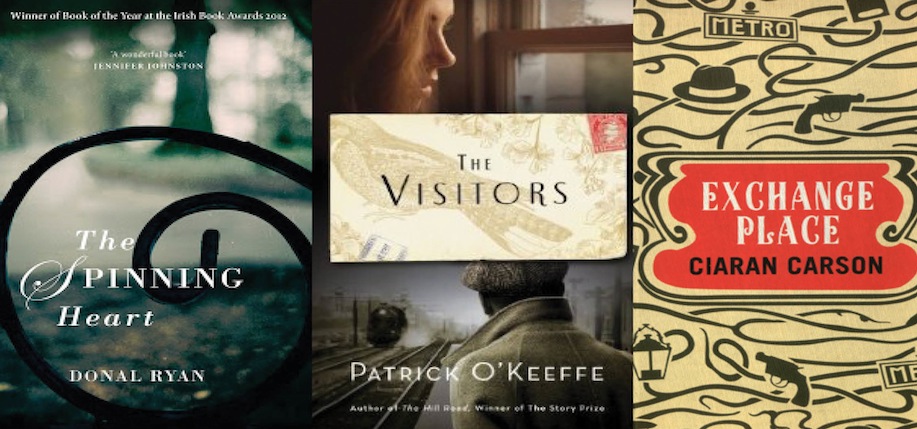Exchange Place
by Ciaran Carson
Ciaran Carson is a writer preoccupied with memory and perception. The author of five other prose collections and ten books of poetry, Exchange Place is Carson’s most recent meditation on these subjects, told through the conceit of a mystery surrounding the decade-old disappearance of a Belfast painter named, depending on who is narrating, either John Harland or John Bourne.
But Exchange Place resists straight narrative, alternating between two perspectives, set in two different cities: John Kilfeather, a Belfast-based writer and antiques dealer with a penchant for smoking fair amounts of marijuana and purchasing fine suits, and John Kilpatrick, also a Belfast-based writer with a penchant for drinking absinthe and purchasing fine suits, who is in Paris working on a travel book to be composed almost entirely of literary excerpts that reference specific locations in the city of light. John Kilfeather is also working on a new project, also composed of quotations and excerpts, a common feature in Carson’s writing too. Thus, identities converge, and in reading Exchange Place, one not only reads Carson, but figures ranging from Walter Benjamin to Oliver Sacks.
Early on in Carson’s novel, if it is right to even call it that, it becomes clear that these two men have more in common than the back cover suggests. In the novel’s own terms, it moves like a fugue through various themes, repetitions, and circuitous paths around the ostensible plot. More a study in tangential writing than the neo-noir the cover may suggest, Exchange Place at times suffers from too much circumlocution and repetition that almost bludgeon the themes of memory formation, truth in perception, and the difference between self identity and prescribed identity. Still, as the novel it self concedes, “One thing was certain: there was more to everything than met the eye.” Double takes might be in order.
– Adam Farley
(Blackstaff Press / £8.99 / 224 pages)
The Spinning Heart
by Donal Ryan
The story of Donal Ryan and his first published novel, The Spinning Heart, is now wide-spread in the literary world and among aspiring writers. A 37-year-old civil servant from Limerick, he wrote two novels and then over the course of three years received 47 rejection letters from publishers and agents. Then his luck rapidly changed. His second manuscript, The Spinning Heart, was released last year in Ireland and the U.K. to vast acclaim and was shortlisted for the 2013 Man Booker prize, selected as the Irish Times Book of the Year and for the 2013 Guardian First Book award. Ryan’s first manuscript, The Thing About December, was just published in Ireland to glowing reviews.
The Spinning Heart makes its U.S. debut on March 4. Reading it, you will say a quiet thank-you to the editor at Doubleday Ireland who saw Ryan’s extraordinary talent. Set in a small Irish town as the painful realities of the economic bust are just settling in, the slim novel is divided into 21 chapters, each containing an internal monologue from a different person in the town. Hopping through time and anecdote – sometimes intersecting, sometimes not – together they provide a deep understanding of their collective and individual experiences.
There’s Bobby Mahon – the protagonist, if it can be said that the book has one – a solidly good man who everyone looks up to and quietly resents. He, along with a number of the other characters, including Vasya, a migrant worker from Khakassia, have been screwed out of their pensions by their construction boss Pokey Burke, who has fled the country (and whose voice, consequently, we never hear). There’s, Realtain, a young mother and incurable flirt who lives in one of two occupied homes in a new 44-house estate, and Milly, a young girl who bears witness to her parents’ toxic marriage. One of the chapters even comes from beyond the grave.
These stream of consciousness narratives, each completely different and yet entirely believable, will make you want to talk to yourself just to see what you might say. While The Spinning Heart’s form and premise harken to Under Milk Wood and the Spoon River Anthology, its content is uniquely evocative of Ireland, thanks to the cultural archetypes Ryan examines and the contemporary realities and nuances he deftly portrays.
– Sheila Langan
(Steerforth Press / $15.00 / 160 pages)
The Visitors
by Patrick O’Keefe
The Visitors is a follow-up to Patrick O’Keefe’s The Hill Road (2005), which won the Story Prize. O’Keefe who emigrated from Ireland in the mid-1980s and now teaches at Ohio University, returns to form with this novel, which is set in Ireland and the U.S., and weaves together the story of two neighboring families, the Dwyers and the Lions, who are connected by love and loss.
Narrated by James Dwyer, the story opens in Ann Arbor, Michigan, with a shabby stranger appearing late one night at James’s door with a request from Kevin Lyons, James’s childhood nemesis, to visit him in New York. Though deeply suspicious of Kevin’s motives, James makes the trip and during the visit, family secrets, that carry over from one generation to another, are revealed.
The language and pace of O’Keefe’s writing is what lifts this story above the commonplace. He deftly sets the scene and captures the idioms of Irish rural life: “My father sat in one of the back seats at Breen’s and ordered a small Powers and a half pint from the barmaid. He knew the barmaid’s father and grandfather. He knew the men sitting back there. Men the same go as him . . .” Just as having grown up in Ireland lends an authenticity to O’Keefe’s writing, so too does the fact that he’s now an immigrant. He ably brings the story stateside with insights in what it’s like to be newly arrived in Boston and put down roots in America.
The Visitors goes on sale March 17, and is definitely a worthwhile read.
– Patricia Harty
(Viking / $26.95 / 275 pages)


like this article